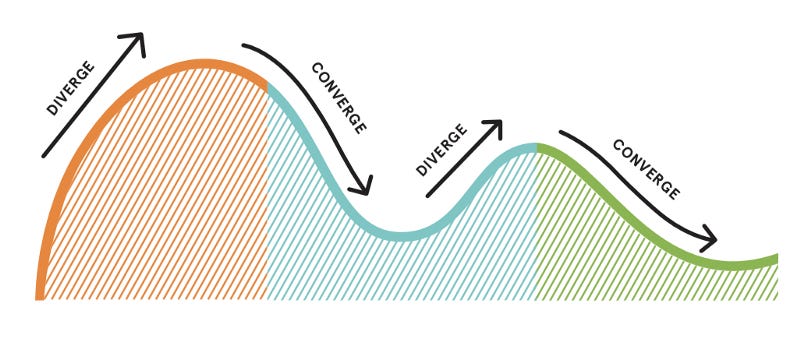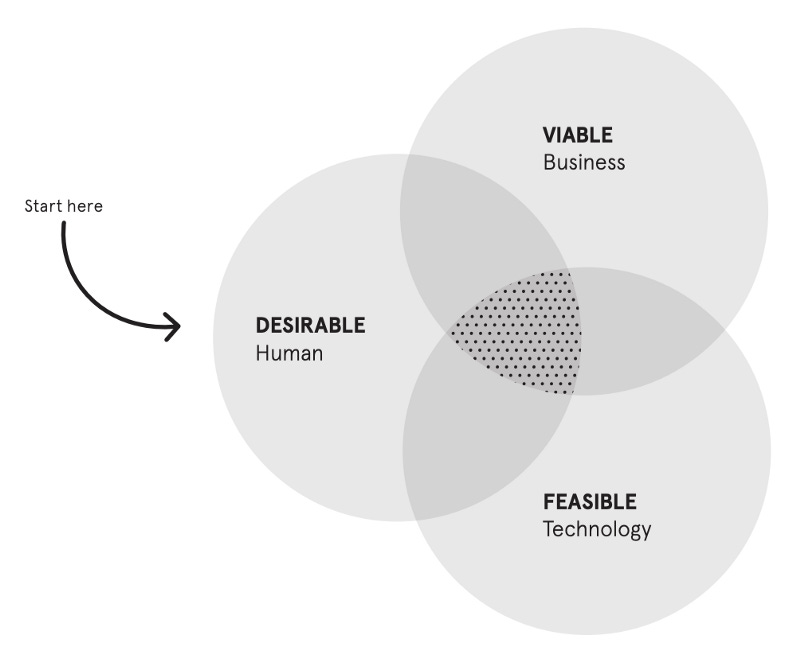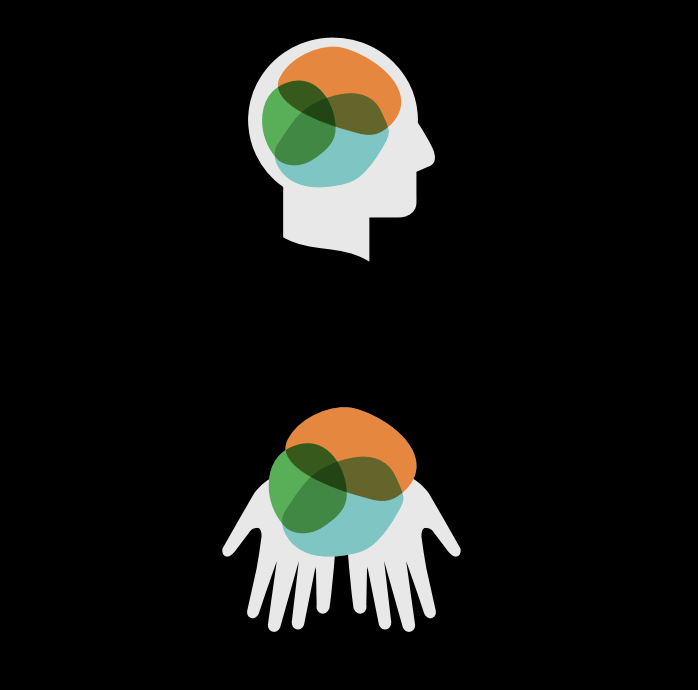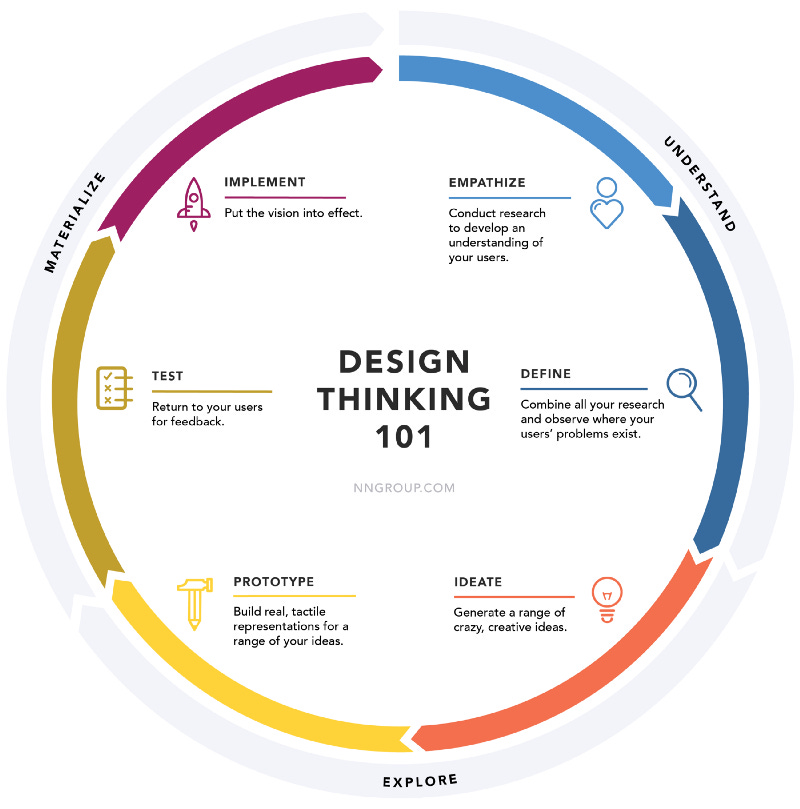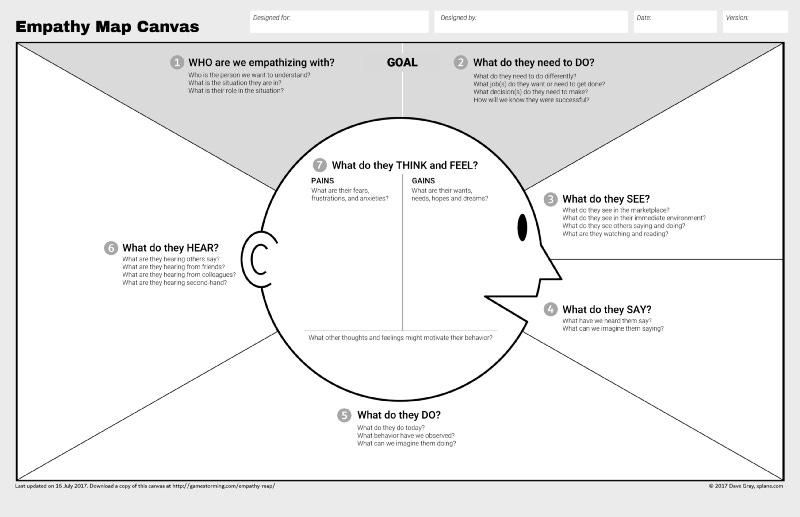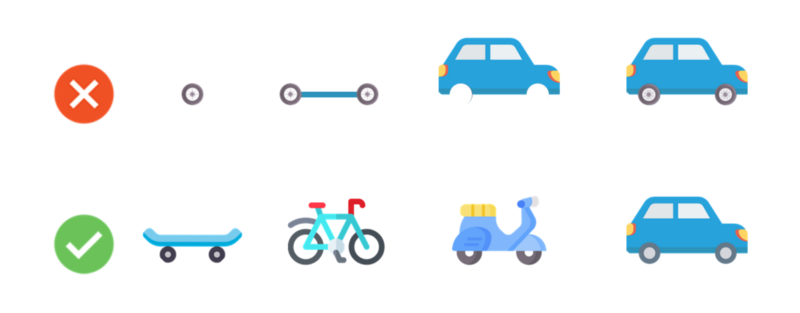Design Thinking: what it is, steps, and how to apply it
Design Thinking is an approach that aims to solve complex user-centered problems. Today, innovation is an essential competitive tool for…
Design Thinking is an approach that aims to solve complex user-centered problems. Today, innovation is an essential competitive tool for the market, as well as being fundamental to increasingly improving the user experience that is intended to be achieved.
As this “leaning ahead” perspective strengthens within companies, looking at the edge before defining the path to be followed is an intelligent way to optimize the process.
Considering that Design Thinking is a concept that can be applied in several areas in order to obtain even better results for your strategies, here in this guide, you will find the primary information on the subject. The topics we will cover are:
What is Design Thinking
How did it come about
Importance of approach
Pillars of Design Thinking
Stages of Design Thinking
Primary tools in Design Thinking
How to start applying to the company
Ways to apply Design Thinking
Books on the topic
Design Thinking Course
Watch until the end to stay in the loop!
What is Design Thinking
Design Thinking is an approach, a way of thinking that can help you solve complex problems. The main characteristic here is that this approach is people-centric. That is, it seeks to involve characters with different perspectives to deeply understand the target audience, their pains, needs, and behaviors. Consequently, the chances of generating a more creative, innovative, and efficient solution are much more significant.
In this case, critical and creative thinking must go far beyond the aesthetic concern of the product. The objective is to offer the user a complete and high-value solution.
How did Design Thinking come about?
The idea of generating increasingly unique and unprecedented solutions for customers emerged around the 1990s with David Kelley and Tim Brown. Both worked at an innovation consulting firm and coined the term by applying a holistic and creative vision to solve their clients’ problems.
Naturally, this perspective has its roots in design, which integrates principles such as simplicity and creativity, creating more positive experiences.
Importance of Design Thinking
It’s not that hard to deduce the importance of Design Thinking now that you know its definition. Over time, consumers are increasingly demanding in the face of so many options that they find in the market. In other words, no one wants to see “more of the same,” especially now that everything evolves very quickly and access to solutions and products is increasingly more accessible.
On the other hand, companies can no longer rely solely on profitability in decision-making. Looking more at end customers and people is the best way to get assertive answers about the next steps. Delivering incredible value and experiences are essential criteria for the success of any brand, service, and product.
Strategic, humanized, creative, and innovative thinking. The Design Thinking approach allows you to align all of this, being an excellent tool for digital business.
Design and User Experience (UX)
Thinking about Product Design and the use of Design Thinking as a design methodology to deliver a valuable solution to the user, it is also worth mentioning the concept of User Experience (UX) or user experience.
According to Peter Morville, thinking about an amazing experience means going beyond usability. In other words, delivering value depends on several other factors, which are powerful resources for a Product team. In 2004 he coined a diagram known as the User Experience Beehive, a model that to this day is considered an excellent reference for Design Thinking.
Here’s what each of these components represents:
Useful/Useful
Following the line of innovation, questioning what you are creating is often necessary. Is the product really useful, or are you just trying to avoid the obvious? Are you really focusing on the usefulness of the solution or just pleasing a customer? What kind of problem can the user solve with it?
Usable / Usability
Although Product Designers should not bias their creativity toward the side of usability (which concerns the ease of handling the product and taking better advantage of its features), it undoubtedly remains a fundamental criterion. This interaction must be simple and intelligent so that the user can make the most of the interface.
Findable/
There is nothing more frustrating than having to search for important information that should be accessible. In the case of Design Thinking in digital products, the idea is that users can find what they are looking for in a short time, without any effort.
Reliable / Credibility
Here we are talking about the focus on creating efficient and satisfying experiences so that users feel safe when using the product in question. An excellent reference on this subject is the Web Credibility Project, the result of research led by the Persuasive Technology Laboratory at Stanford University.
Accessible / Accessibility
A well-designed product must also be inclusive. That is, to develop a complete solution, people with disabilities must also be able to make the most of the benefits and features (considering the whole strategic proposal, of course).
Desirable
This is where emotional design plays its strongest role. This means that, in addition to being a product that provides benefits, is easy to use and also reliable, it is essential that the user has some pleasure in having contact with this solution. This is where more abstract aspects, such as the feeling of power and association with the brand, come in.
Valuable / Valuable
We have the product's actual value from the union of all these factors. That is, it is a complete experience that meets the user’s needs, is pleasant, straightforward, and serves a greater purpose.
Pillars of Design Thinking
Design Thinking has three pillars that are nothing more than approach values. It is essential that all of them are respected so that you are actually innovating and promoting a good experience.
They are empathy, collaboration, and experimentation :
Empathy
One of the challenges posed by Design Thinking is to cling to empathy to free yourself from pre-judgments and a whole context of personal convictions that can divert creative thinking.
Understanding other people’s contexts and delving into their needs is essential to finding solutions that truly serve the user or customer — not the ones you believe they are.
Collaboration
Collaboration is also about being open to dealing with the other, considering impressions and interpretations of those who come from a different context than yours. Talking and listening to professionals from other areas with multidisciplinary skills is something that significantly enriches the process.
Collaboration is also closely associated with the innovation process of Design Thinking since we intend to bring different people with different contexts and perspectives to debate the same subject. Thus, the solutions developed tend to address pain from a point of view that a single person could not foresee, delivering more value to the customer.
Experimentation
One thing we are sure of these days is that there is no cake recipe or magic secret to success. All we have are hypotheses that need to be validated — and the sooner that happens, the better. After all, the sooner you identify an error, the sooner you minimize its damage and risks.
Therefore, experimentation must be constant. Eliminate absolute truths that only exist in theory, identify opportunities for improvement, and move forward whenever possible.
Stages of Design Thinking
Design Thinking is divided into 4 stages: immersion, ideation, prototyping, and development.
But, before we talk about each of them, it is worth noting that any approach that aims to find a solution must start with a previous step of understanding and observation.
That is, it is essential to meet with your team, plan the work to be carried out and define rules and parameters that will guide the proper execution of the tasks. Likewise, analyzing the user’s context and observing the present problems is essential to understanding the obstacle to be overcome.
Once that’s done, it’s time to move on to the solution!
1. Immersion
Immersion is the stage in which you will seek to understand your company's context deeply. There’s not much of a secret here: do a SWOT analysis (to identify strengths, weaknesses, threats, and opportunities), invest in discovery, collect customer feedback and open up to your employees too.
Immerse yourself in organizational culture and try to understand how your company is seen from the inside and outside. Also, consider external market factors (politics, economy, competitors) and gather all the useful information you can and consolidate it, seeking connection with the objective of the product or the theme that gave rise to the need to use Design Thinking.
2. Ideation
Ideation means producing ideas. After completing the first step, you will have the necessary material to let creativity enter the process, focusing on the points that need improvement.
Brainstorming is a widely used and recommended strategy because it assumes that everyone can contribute without fear of judgment. This creates a scenario where people are more comfortable expressing their opinions, and that’s how great ideas come about.
3. Prototyping
Prototyping is nothing more than the testing phase of Design Thinking. In it, you must gather the best ideas raised in the ideation process, considering those that have the most significant potential and the chance of success.
A prototype is a test version of a product or functionality. This means that it is not the final version of what you imagined but a validation version. The proposal is to know if the idea goes ahead or not, avoiding unnecessary expenses. At this stage, the focus is to learn from the feedback to refine your initial idea.
It’s not uncommon for a prototype to need tweaking. In fact, the idea is that validation with clients and users happens as changes are made, getting closer and closer to the ideal result.
4. Development
After completing the entire prototyping stage, that is, after validating your solution with your users and having a satisfactory acceptance rate, it’s time to make it happen for real, completing the Design Thinking phases.
Gather all the improvements, finalize the official version of the product and prepare your go-to-market strategy.
Main tools in Design Thinking
In order for you to be able to absorb the best of each stage of Design Thinking, there are tools and methodologies that help execute this entire process. Here we have selected some of the main ones:
Empathy Map
The Empathy Map is beneficial for the first stage of Design Thinking, as it starts from collaborating between teams to gain insights into customer needs. In a very visual and in-depth way, the proposal is to answer questions such as:
What does the user think and feel?
What does he hear, see, speak and do?
What are your pains?
What are your wishes?
Brainstorming
As we have already seen, brainstorming is a dynamic that helps in the ideation stage. For the collaboration to have the expected result, it is important that everyone is willing to participate without judgment, focusing on a very well-defined problem.
Some good practices that contribute to assertive and productive brainstorming are:
Have a person responsible for coordinating the process;
Provide visual reinforcement for the proposed ideas (post-its are very useful);
Organize so that everyone has a speaking time (which must be respected);
Stay focused on the goal and avoid side conversations.
MVP
The MVP (Minimum Viable Product ) is helpful for prototyping and idea validation. The objective is to build a more straightforward and leaner version of the product, using as few resources as possible but adding the principal value that the solution must deliver.
Therefore, it is essential to have a full understanding of the value proposition to put this concept into practice, as well as to define a customer base that will be able to validate all this.
How to start applying Design Thinking in the company
Now that you know the phases of Design Thinking and its tools, it is worth stressing that this is a very versatile concept that goes beyond the business world. Therefore, any company can benefit from adopting this way of thinking about products and services.
Therefore, the important thing is to encourage an organizational culture that fits this proposal. Some things that can help in this process are:
Stimulate creativity among teams;
Involve people from different areas, bringing diversity of perspectives to the process;
Appreciate the added value to your product, service and brand, keeping all professionals always connected to it;
Encourage constant concern for the experience of users and customers;
Invest in actions that promote empathy, collaboration and cooperation between teams.
In other words, the implementation of Design Thinking as a mindset will depend a lot on the context of each company . It is important to know the organization well and, little by little, make this concept present in the development of new products, features and services.
Ways to apply Design Thinking
There are methodologies for Design Thinking that you can adopt as a process in your company’s routine. They work as structuring alternatives, which can be adjusted to your company's context. Below, we list the main ones:
Double Diamond Design
Double Diamond is a Design Thinking methodology created by the British Design Council in 2005. The idea is to start with a broad research, raising numerous hypotheses, and then move on to moments of choice . This technique is very unique for arriving at the solution proposal from the ideation stage.
Design Sprint
The Design Sprint, on the other hand, is an agile method that proposes the creation of digital products in just 5 days . This structuring model was conceived by Google Ventures , the venture capital investment department of Alphabet Inc and Google.
Briefly, the principles of Design Thinking are allocated to the days of the week:
Monday: understanding and definition (immersion and definition of objectives);
Tuesday: divergence (exploration of ideas);
Wednesday: decisions (selection of ideas);
Thursday: prototyping (assignments, responsibilities and deadlines);
Friday: validations (testing phase).
Lean Design
Lean Design incorporates Lean Methodology into the practice of Design Thinking. The technique, also known as “lean development” , is based on the proposal to eliminate excesses that can delay the process of creating a product.
For this, the 5 lean principles described in the book “ Lean Thinking: banish waste and create wealth in your corporation ” are considered:
Value: clarifies the value of the product;
Value stream: identifies the steps that add value to the product;
Continuous flow: seeks process fluidity, achieving uninterrupted production;
Pull production: works the next actions directly on top of consumer needs;
Perfection: Establishes a process of continuous improvement.
Books on Design Thinking
One of the most famous books on Design Thinking is undoubtedly “ Design Thinking: A Powerful Methodology for Enacting the End of Old Ideas ” by Tim Brown himself. If you want to understand how the concept came about, this is a light read that will be very useful. But you might also like:
“ This is Service Design Thinking: Fundamentals, Tools, Cases ”
On the other hand, if you want to expand your knowledge and also check out other titles that address the importance of design for the user experience, it’s still worth checking out:
“ The Design of Everyday Things ”
“ Intertwingled: Information Changes Everything ”
“ The Laws of Simplicity ”



